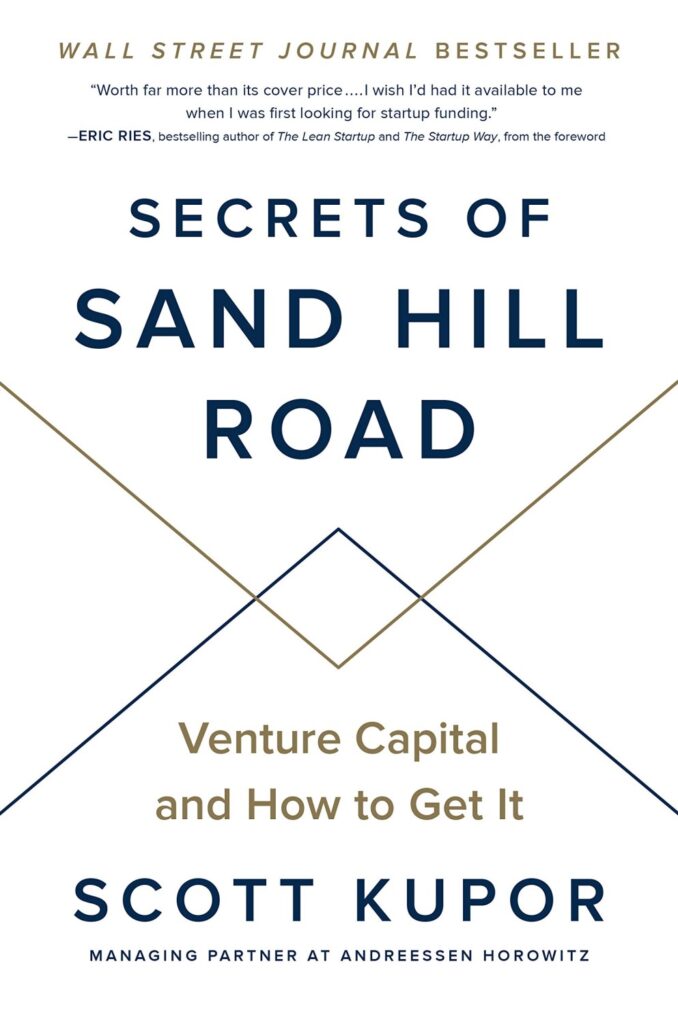
I knew when I first heard about Scott Kupor’s “Secrets of Sand Hill Road“ I would want to write a review of it. For one thing, very few top-tier venture capitalists have written books about venture capital, which has remained a fairly well kept, if not intentional, secret. My theory is that most of the top VCs are too busy becoming billionaires to write about it.
My second reason for wanting to write about this book is that over a period of 20 years I spent a significant percentage of my time in Silicon Valley and I find it a very special place. In the early 1980s, I managed the Vidar Transmission Products division of TRW In Silicon Valley. It manufactured transmission products for digital telephone systems. I had an office and a manufacturing facility in Mountain View for several years.
When I managed 3i Ventures, I had a secondary office at 3000 Sand Hill Rd., the home of many Silicon Valley VC firms. I served on the board of directors of a handful of Silicon Valley companies. I watched Don Valentine, founder of Sequoia Capital, do a masterful job of leading Sierra Semiconductor to success. 3I Ventures syndicated numerous venture capital investments with top Silicon Valley VC firms. I served on boards with John Jarve of Menlo Ventures, Vinod Khosla of Kleiner, Perkins, Peter Thomas of Institutional Venture Partners, Pierre Lamond, of Sequoia Capital, and Wilf Corrigan, founder of LSI Logic, to name just a few. In the early 2000‘s, I served as co-founder and Chairman of DRC computer, a reconfigurable computing startup headquartered in Santa Clara, California.
When I was most active on Sand Hill Road, the Silicon Valley venture capital funds made many startup Series A investments, most of which were syndicated among several VC firms. The largest partnerships managed about $150 Million in a single fund. Scott’s venture capital world of today is very different. The top-tier Silicon Valley funds have become very large—often in excess of $1 Billion—which makes it difficult for them to do many startup investments or to syndicate with other VC firms. So, there are some significant differences in the Silicon Valley venture capital climate then and now.
Silicon Valley contains the greatest concentration of high-tech activity in the world. In an area of less than 50 square miles, there are over 2000 high technology companies and at least 60 venture capital firms. This results in a very concentrated excitement and buzz around technology and new startup companies. it is difficult to understand if you haven’t been part of it—if you haven’t seen restaurants full of executives and VCs, networking events with a high concentration of investors, the steady parade of pitch deck presentations and the flood at times of acquisitions and IPOs.
Silicon Valley and Sand Hill Road are the right place to examine the inner workings of venture capital, and Scott Kupor has done an excellent job of that.
Early in the first chapter, Scott. makes it clear that he wants to help “entrepreneurs” raise venture capital. I thought this was an interesting choice of words. A few months ago I did a word-count survey of “entrepreneurship,” “successful CEOs,” and “successful startups.“ The article is published on LinkedIn. (“Entrepreneurship vs. Executive Management.”) The result was that the primary goals of entrepreneurs seem to be determination and passion. Whereas the focus of successful managers is process. And the primary focus of successful startups is market analysis and understanding. In my experience, successful venture backed startups involve a blend of all three.
Scott cites Y Combinator as having educated an enormous number of entrepreneurs. To me, there is likely to be some distance between an educated entrepreneur and a “fundable CEO,” who probably has 15–20 years of management experience under his belt. Building successful startups certainly involves passionate entrepreneurship, but I believe the top venture capital firms also place strong emphasis on investing in skilled and proven management teams. Success may be more about management process and market understanding than about passion and determination.
When a VC invests in a company, it is unlikely to invest in another company in the same industry segment. This is an interesting observation. It means that VC firms are under great pressure to get it right the first time. They want to invest in industry leaders not “number two“ or “number three.” So, when a startup approaches a venture capital firm, it is not only competing against dozens of other firms for capital, it must make a strong case that it will be the dominant player in its industry sector.
Chapter 5 is an interesting discussion of how limited partners team up with venture capital firms to provide capital for investment. It’s worth knowing this because it explains why venture capitalists—although they take significant risk in every investment—at the same time, make every effort to manage and reduce risk. Their limited partners are institutions like Harvard, CALPERS, or Yale who have very aggressive return on investment targets. They hope to exceed stock market returns by a significant amount every year.
In Chapter 6, Kupor makes an interesting argument for “vesting“ of founders’ shares, possibly over a four-year period. This is extremely important. The basic concern being addressed is, “What if a founder leaves after a short period of time?” Nobody expects that to happen, but it can create significant stress among founders if it does. I watched one company completely implode over this issue. The founders did not want to do a “buyback” of unvested shares, so they tried to stage the purchase of founders’ shares over a 2-3-year period—at the original share price—which would have been a violation of tax law. There are two good lessons for founders here: 1) Plan vesting carefully and 2) Get help from a corporate attorney who works with startups.
Scott’s discussion of IPOs left me a bit puzzled. He essentially says in today’s world, it can take 10 years for a startup to become IPO material. I don’t see the changes in IPO timing as a trend, but more as a cycle. I think we will still see periods when companies can get to IPO status in 3-5 years. There’s no question that the bursting of the “.com” bubble pushed the timing out to something like 8-10 years. But I don’t think it’s here to stay. I think it’s largely a function of stock market levels and IPO market demand, and I believe the demand will return. Recently it’s been soured a bit high a couple of bad IPOs.
Here, from The Fundable Startup, is a summary of IPO cycles since 1980:
Unfortunately, access to the IPO market comes in unpredictable bursts of activity, which usu- ally do not last very long. According to Quandl, a source for financial and economic data, from 1980 to 2015 there were five time periods when the number of IPOs exceeded approximately sixty per year:
• 1983–1984
• 1986–1987
• 1992
• 1994–1995
• 1996–1999
Startup Capital: Recent History 59
The Quandl study shows that from 1980 to 2015, the IPO market was robust to the extent of producing over sixty IPOs per year for only ten of the thirty-six years. Moreover, there were fewer than sixty IPOs for almost all of the years between 1999 and 2015. (Professor Jay Ritter, “Historical U.S. IPO Statistics,” quandl.com, accessed on April 16, 2016.)
Scott’s Chapter 7 does a great job of addressing, “How much capital should you raise, and at what valuation?“ The “how much?” answer is based on milestones and future funding needs. In discussing the discounted cash flow method of valuing companies, I think he dismisses the approach a little too quickly. He says startups have multiple years of negative cash flow, so the method doesn’t apply. But I think the method handles those negative cash flows just fine. It just puts more emphasis on the later years and the terminal value in determining valuation. Scott might argue that estimating these values is guesswork—and to some extent it is. But I think you just have to do a lot of research, sharpen your pencil, and take your best shot. Otherwise, the entire process is guesswork.
Secrets contains an extensive discussion of venture capital term sheets in Chapters 9 and 10. It also presents a great discussion of “corporate governance,” a topic which is overlooked by startups that do not have experienced company-builders on their board. It is extremely important for startup directors to understand their obligations to the company as well as their legal responsibilities. Including the often referenced “business judgment” rule.
In his closing, Scott. asks the question, “How did we get to this point where venture capital ceased to be a scarce resource?“ His answer relies on the supposed reduction in cost of financing startup companies. That’s probably true in some segments like software and web apps, but I am not sure it’s true across the board. Salaries are still salaries; chips and metal are still chips and metal. Some companies still require significant capital.
I would give a different answer—that the gatekeepers who advise institutions as to where to invest their venture capital allocations keep sending money to the same top-tier venture capital funds, most of which are located in Silicon Valley. This has been happening since the early 1990s, and it has led to a “rich get richer, poor get poorer“ structure in the venture-capital industry. I don’t think it is so much that there’s too much money, as it is that a few top performing funds have so much capital that they have a difficult time dealing with startup investments.
Scott speculates that crowdfunding and initial coin offerings might spell “the end“ for venture-capital. I really don’t believe this. Elsewhere in the book Scott makes the point that venture capitalist—although they invest in a very small percentage of startups—are involved in about 42% of IPOs. I think the venture capitalist do a great job of cherry picking the winners and that the crowd-funders are going to have a very difficult time replicating that success. I will be very surprised if many make attractive returns except on an anecdotal basis.
Finally, Scott discusses, “What makes a good VC?” It’s very important that startups understand that the top VCs add extraordinary value to a startup. They can help in many ways, including providing experienced guidance, making strategic introductions, helping with downstream fundraising, helping retain a strong team, and many other factors that have led to extremely successful venture-backed exits.
How do Secrets and The Fundable Startup compare? Both address the fundamentals of venture capital and how it works. Secrets gives a broader view in the context of Silicon Valley. The Fundable Startup provides startups with specific programs and strategies for attracting capital.
Anyone contemplating a startup as founder or team member should read Secrets of Sand Hill Road and absorb its insightful lessons.


Recent Comments